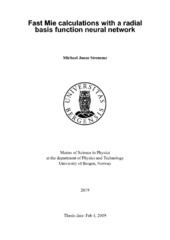Fast Mie calculations with a radial basis function neural network
Master thesis
Permanent lenke
https://hdl.handle.net/1956/19146Utgivelsesdato
2019-02-22Metadata
Vis full innførselSamlinger
Sammendrag
Scattering phenomena have been of great interest and driving scientific advancement for centuries. Mie theory outlines a precise way to compute the scattering by spherical particles. However, the computational labor involved in Mie calculations are very time consuming. Computer modeling of light intensities often are heavily dependent on calculations of absorption and scattering of radiation interactions. Maxwell’s equations for such large particles require very many expansion terms which slow down the computation time. Using Mie theory, this thesis aims to investigate the use of artificial neural network in order to decrease computation time for a wide variety of particle size distributions and refractive indices. The input and output parameters of the Mie code will be used to train an artificial neural network in an attempt to increase the speed of such calculations, while still being reasonably accurate. The a single radial basis function neural network with 300-500 neurons is enough to approximate the scattering coefficient, absorption coefficient and asymmetry parameter with an mean absolute percentage error of less than 2%. However the potential of outlier errors of up to 20-30% exists with the currently iteration of neural network. The time save of a neural network can be enormous with a potential improvement of 10000 times faster than traditional Mie codes.
